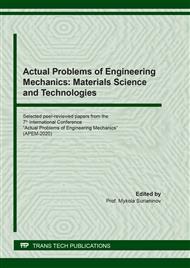[1]
Sidney Freedman, et al., Architectural Precast Concrete, third ed., PCI Architectural Precast Concrete Manual Committee, (2007).
DOI: 10.15554/mnl-122-07
Google Scholar
[2]
V.I. Kаlаshnikov, O.V. Suzdaltsev, M.N. Moroz, V.V. Pausk Frost Resistance of Coloured Architectural-Decorative Powder-Activated Sand Concretes, Building Materials, 2015, no.3, pp.16-19.
Google Scholar
[3]
А.E. Sheikin, Structure, durability and crack resistance of cement stone, Мoscow, Stroyizdat, (1974).
Google Scholar
[4]
V.S. Ramachandran, R.F. Feldman, Y.Y. Beaudoin, Concrete science: Treatise on Current Research, Мoscow, Stroyizdat, (1986).
Google Scholar
[5]
E.I. Kolokolnikova, Durability building materials (concrete and reinforced concrete), Мoscow, Vischa Shkola, (1975).
Google Scholar
[6]
O.Ya. Berg, E.N. Shcherbakow, G.N. Pysanko, High-strength concrete, Мoscow, Stroyizdat, (1971).
Google Scholar
[7]
James R. Clifton, The frost-resistance of concrete, National Institute of Standards and Technology, (1990).
Google Scholar
[8]
S.V. Shestoperov, Concrete technology, Мoscow, Vischa Shkola, (1977).
Google Scholar
[9]
C. Müller, S. Palm, A. Wolter, T. Bohne, Characteristic values based on degree of hydration for predicting the durability of concrete. Cement international: technology, properties, application, 2017, no. 1, pp.28-35.
Google Scholar
[10]
V.I. Solomatov, V.N. Vyrovoy, V.S. Dorofeev, A.V. Sirenko, Composite building materials and constructions of the reduced material capacity, Kіеv, Budivelnik, (1991).
Google Scholar
[11]
A.M. Neville, Properties of concrete, Мoscow, Stroyizdat, (1972).
Google Scholar
[12]
Kefeng Tan, John M. Nichols, Frost Resistance of Concrete with Different Strength Grades and Mineral Admixtures. Modern Civil and Structural Engineering, 2018, Vol. 2, no. 1.
Google Scholar
[13]
Steven H. Kosmatka, et al., Design and Control of Concrete Mixtures, 14th ed., The guide to applications, methods, and materials, (2011).
Google Scholar
[14]
M. Pigeon, et al., Freezing and thawing tests of high-strength concretes, Cement and Concrete Research, 1991, Vol. 21, Issue 5, pp.844-852.
DOI: 10.1016/0008-8846(91)90179-l
Google Scholar
[15]
L.J. Dvorkin, E.M. Babich, High-strength quick-hardening concrete and fiber-reinforced concretes, NUWEE, Rivne, (2017).
Google Scholar
[16]
Gai-Fei Peng, Qiang Ma, Hong-Mei Hu, Ri Gao, Qian-Feng Yao, Ye-Feng Liu, The effects of air entrainment and pozzolans on frost resistance of 50–60 MPa grade concrete. Construction and Building Materials, 2007, Vol. 21, Issue 5, рр. 1034-1039.
DOI: 10.1016/j.conbuildmat.2006.02.002
Google Scholar
[17]
Y.M. Bazhenov, Concrete technology, Мoscow, АСВ, (2003).
Google Scholar
[18]
F.M. Li, The chemistry of cement and concrete, Мoscow, Stroyizdat, (1961).
Google Scholar
[19]
Memduh Nas, Şirin Kurbetci, Mechanical, durability and microstructure properties of concrete containing natural zeolite, Computers and Concrete, 2018, Vol. 22, no. 5.
Google Scholar
[20]
A.D. Dovgan, V.M. Vyrovoy, P.M. Dovgan, Water absorption as a function of decorative concrete warehouses, Сollection of scientific works, Resource and economic materials, structures, buildings and constructions, NUWEE, Rivne, 2020, no. 38, рр. 148-160.
Google Scholar
[21]
P.M. Dovgan, A.D. Dovgan, T.V. Lyashenko, N.V. Hlitsov, Experiment planning in the study of decorative sand concrete, Structure formation, strength and destruction of composite building materials and structures, OGASA, Odessa, 2018, pp.27-30.
Google Scholar
[22]
T.V. Lyashenko, A.D. Dovgan, P.M. Dovgan, Decorative concrete with hybrid glass fibre: design and first results of the experiment, Bulletin of Odessa State Academy of Civil Engineering and Architecture, OGASA, Odessa, 2018, Vol. 70, pp.99-105.
DOI: 10.31650/2415-377x-2020-78-79-88
Google Scholar
[23]
T.V. Lyashenko, V.A. Voznesensky, Composition-Process Fields Methodology in Computational Building Materials Science, Astroprint, Odessa, (2017).
Google Scholar
[24]
А.А. Pashchenko, The reinforcement of inorganic binders with mineral fibers, Kіеv, Vischa Shkola, (1979).
Google Scholar
[25]
S.V. Shestoperov, Durability concrete transport buildings, Мoscow, Transport, (1966).
Google Scholar


